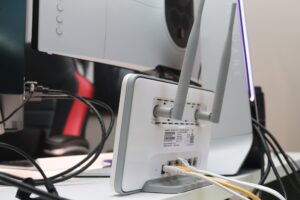
WiFi Congestion Causes and Troubleshooting Tips

What is WiFi congestion?
WiFi network congestion is caused by too many transmissions traveling through the radio frequency (RF) environment at any given time.
Every WiFi task requires the transmission of data packets. These packets travel through the RF environment, directed by switches/routers within the company’s network and internet, so that each task can be accomplished. This includes everything from making a video call, to sending an email, to completing a financial transaction.
If this network traffic exceeds the bandwidth of the network’s design, there is effectively a traffic jam. This congestion can then cause data packet issues, which can result in packets being sent more than once. This adds additional traffic, worsening the congestion.
What issues are caused by congestion?
End user experience will suffer as users face higher latency, slower speeds, frequent disconnects and reconnects, or even an inability to connect at all.
Why are my WiFi channels congested?
There isn’t only one answer to this question, and oftentimes, more than one issue is at the root of congestion. A few culprits include:
Overcrowded networks
If a network is overloaded, congestion is going to be a constant problem. Device overload can occur slowly over time, for instance, if an organization has grown from 50 to 150 employees but hasn’t redesigned their network; or it can occur all-at-once, perhaps during a conference or other event.
Co-channel interference (CCI)
CCI occurs when two or more APs use the same WiFi channel. This causes slower speeds as each device has to wait until the channel is clear to transmit.
If capacity issues are forcing you to “double up” channels, you may want to look into WiFi 6. It helps this issue with OFDMA and MU-MIMO technologies – allowing APs to talk to more than one client at a time and allowing clients to share channels – but you’ll still want to dedicate one channel per AP frequency.
Adjacent channel interference (ACI)
When APs are using adjacent channels in close proximity to each other, this can cause adjacent channel interference. In less crowded environments, this doesn’t cause any issues, but it’s a different story in dense deployments.
When your network exists in a busy school, a large enterprise, or is one of many in a crowded office building, ACI is a common cause of interference and congestion issues.
WiFi signals outside of your network
WiFi is a shared medium. This means that your network is sharing the airwaves with any nearby networks. This includes businesses, homes, and schools, as well as individual hotspots, which can be anything from an employee’s or guest’s phone to an AP in a car equipped with WiFi.
Non-WiFi sources
As a part of the RF environment, your network can be impacted by any radio waves transmitting over the shared airspace. This includes Bluetooth devices, microwaves, radio transmitters, and cordless phones.
How do I reduce WiFi congestion?
To improve your WiFi, the best thing you can do is proactively and consistently analyze your WiFi network performance. By analyzing all network traffic 24/7 and running scheduled network tests, IT always has eyes on the network and can respond to issues before end users are affected.
To support this proactive response, you’ll want the following capabilities.
Complete network visibility
To pinpoint the root cause of congestion, IT teams need to know exactly what is connected to the network and what each device is consuming for WiFi bandwidth. This visibility must extend to all infrastructure, non-WiFi sources of interference, and any nearby networks sharing the airspace.
Only with this information can IT accurately determine the root cause of every issue. If there are any blind spots – any data packets that aren’t collected and analyzed – network optimization loses out.
Scheduled network tests
Network performance tests should run consistently to provide IT with the most up-to-date information. For the best ROI, work with a testing tool that automatically runs tests, automatically alerts IT to any failures, and includes root cause identification with all alerts. With this data, IT can significantly reduce resolution times.
You should also look for a tool that connects to the network as an end user device, ensuring that all performance metrics accurately reflect the end user experience.
While most people think of testing WiFi speed to identify performance issues, tests should also include:
- Wireless connectivity and internet connectivity
- Security audit
- Server tests
- Device discovery test
- Application test
Testing the entire network ecosystem gives IT a holistic view of network performance, allowing teams to resolve any issues that are causing congestion.
Saved historical wireless analytics
It’s important to monitor long-term trends in WiFi network health and performance. While a network may be performing well in real-time, these trends can reveal specific ways that the network needs to be upgraded in order to prevent future congestion.
For example, historical data can answer questions such as:
- Is a network nearing capacity?
- Which areas of a building are the most congested?
- Did performance change after a building renovation or after a new business opened nearby?
Remote access
With this capability, IT professionals can access the network from any location and resolve issues as soon as alerts are received.
What effect do automatic analytics have on WiFi congestion?
In order to achieve the above capabilities in a cost-effective manner, organizations should work with a WiFi automation platform. These platforms automate the above tasks, freeing up IT resources to focus on other critical responsibilities. Without an automation platform, IT professionals would need to spend 24 hours a day running tests and analyzing data packets in real-time to achieve the same results.
The exact effects an organization experiences will depend on the automation platform that is selected. Organizations that use the Wireless Intelligence Platform™ (WIP) report:
- 90% faster Mean-Times-to-Resolution
- 70% fewer WiFi problem tickets
- 80% fewer remote site visits
To see WIP in action and start optimizing your network today, schedule a free demo or trial.


